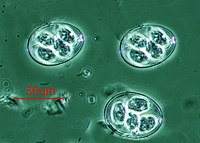
Coxiella burnetii in camels (Camelus dromedarius) from Algeria: seroprevalence, molecular characterization, and ticks (Acari: Ixodidae) vectors.
Sign Up to like & getrecommendations! Published in 2020 at "Acta tropica"
DOI: 10.1016/j.actatropica.2020.105443
Abstract: Q fever is a widespread zoonotic disease caused by Coxiella burnetii that most commonly infects not only a variety of mammals but also arthropods and in particularly ticks. The aim of this study was to detect… read more here.
Keywords: seroprevalence; coxiella burnetii; burnetii camels; burnetii ... See more keywords

Overexpression, purification and enzymatic characterization of a recombinant Arabian camel Camelus dromedarius glucose-6-phosphate dehydrogenase.
Sign Up to like & getrecommendations! Published in 2018 at "Protein expression and purification"
DOI: 10.1016/j.pep.2015.09.002
Abstract: In a previous study the full-length open reading frame of the Arabian camel, Camelus dromedarius liver cytosolic glucose-6-phosphate dehydrogenase (G6PD) cDNA was determined using reverse transcription polymerase chain reaction. The C. dromedarius cDNA was found to… read more here.
Keywords: camel camelus; phosphate dehydrogenase; glucose phosphate; dromedarius ... See more keywords

Mapping the Distribution of Special Structured Pulmonary Vasculatures in the Dromedary Camel (Camelus dromedarius): Histological and Histochemical Study
Sign Up to like & getrecommendations! Published in 2022 at "Microscopy and Microanalysis"
DOI: 10.1017/s1431927622000381
Abstract: Abstract Dromedary camel (Camelus dromedarius) is adapted to survive the harsh environments. It has some key adaptation peculiarities in various organs. In this study, we aimed to map the distribution pattern of unique regulatory devices… read more here.
Keywords: camelus dromedarius; camel camelus; histological histochemical; dromedary camel ... See more keywords

Molecular epidemiology and phylogeny of spotted fever group Rickettsia in camels (Camelus dromedarius) and their infesting ticks from Tunisia.
Sign Up to like & getrecommendations! Published in 2019 at "Transboundary and emerging diseases"
DOI: 10.1111/tbed.13392
Abstract: Rickettsia species are adapted to a wide range of specific animal hosts. Camels (Camelus dromedarius) have been identified as a carrier of various zoonotic pathogens and became a focus of growing public-health interest. This study… read more here.
Keywords: infesting ticks; rickettsia; epidemiology; monacensis ... See more keywords

Identification of Macroscopic Sarcocysts of Sarcocystis cameli from One-Humped Camel (Camelus dromedarius) in Iraq
Sign Up to like & getrecommendations! Published in 2017 at "Journal of Parasitology"
DOI: 10.1645/16-135
Abstract: Abstract There is considerable confusion concerning the identity of macroscopic Sarcocystis species in camels. Currently 2 species, Sarcocystis cameli and Sarcocystis ippeni, are recognized from 1-humped camel (Camelus dromedarius), and sarcocysts of both species are… read more here.
Keywords: camel camelus; macroscopic sarcocysts; macroscopic; humped camel ... See more keywords

Gross Morphological and Ontological Studies on Pituitary of Camel (Camelus dromedarius)
Sign Up to like & getrecommendations! Published in 2019 at "Pakistan Veterinary Journal"
DOI: 10.29261/pakvetj/2019.116
Abstract: Received: Revised: Accepted: Published online: March 24, 2018 May 17, 2019 October 22, 2019 November 11, 2019 Thirty normal male and female camels (Camelus dromedarius) with three age groups (2-4, 5-10 and 11-onward years) were… read more here.
Keywords: camel; age; body weight; gross morphological ... See more keywords

Beyond the Big Five: Investigating Myostatin Structure, Polymorphism and Expression in Camelus dromedarius
Sign Up to like & getrecommendations! Published in 2019 at "Frontiers in Genetics"
DOI: 10.3389/fgene.2019.00502
Abstract: Myostatin, a negative regulator of skeletal muscle mass in animals, has been shown to play a role in determining muscular hypertrophy in several livestock species, and a high degree of polymorphism has been previously reported… read more here.
Keywords: polymorphism; myostatin; gene; camelus dromedarius ... See more keywords

Coxiella burnetii in Dromedary Camels (Camelus dromedarius): A Possible Threat for Humans and Livestock in North Africa and the Near and Middle East?
Sign Up to like & getrecommendations! Published in 2020 at "Frontiers in Veterinary Science"
DOI: 10.3389/fvets.2020.558481
Abstract: The “One Health” concept recognizes that human health is connected to animal health and to the ecosystems. Coxiella burnetii–induced human Q fever is one of the most widespread neglected zoonosis. The main animal reservoirs responsible… read more here.
Keywords: dromedary camels; coxiella burnetii; north africa; burnetii ... See more keywords

Presentation, Clinical Pathology Abnormalities, and Identification of Gastrointestinal Parasites in Camels (Camelus bactrianus and Camelus dromedarius) Presenting to Two North American Veterinary Teaching Hospitals. A Retrospective Study: 1980–2020
Sign Up to like & getrecommendations! Published in 2021 at "Frontiers in Veterinary Science"
DOI: 10.3389/fvets.2021.651672
Abstract: Old World Camelids (OWC) represent two species (Camelus bactrianus and Camelus dromedarius) with increasing numbers in North America. Gastrointestinal (GI) parasitism is a major cause of clinical disease in camelids and leads to significant economic… read more here.
Keywords: pathology; camelus bactrianus; bactrianus camelus; clinical pathology ... See more keywords

Structural and Functional Characterization of Camelus dromedarius Glutathione Transferase M1-1
Sign Up to like & getrecommendations! Published in 2022 at "Life"
DOI: 10.3390/life12010106
Abstract: Glutathione transferases (GSTs; EC. 2.5.1.18) are a large family of multifunctional enzymes that play crucial roles in the metabolism and inactivation of a broad range of xenobiotic compounds. In the present work, we report the… read more here.
Keywords: camelus dromedarius; glutathione; gsh; characterization ... See more keywords

Assessment of Seroprevalence and Associated Risk Factors for Anaplasmosis in Camelus dromedarius
Sign Up to like & getrecommendations! Published in 2022 at "Veterinary Sciences"
DOI: 10.3390/vetsci9020057
Abstract: (1) Background: Anaplasmosis is an infectious disease in camels caused by an obligate intracellular bacterium that is transmitted by ticks. (2) Methods: A cross-sectional study was conducted during 2020 to study the seroprevalence of Anaplasma… read more here.
Keywords: risk; camelus dromedarius; associated risk; anaplasmosis ... See more keywords